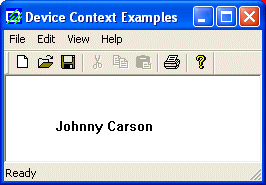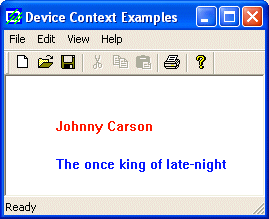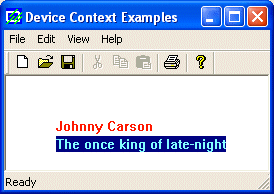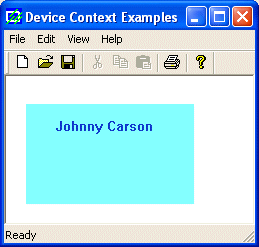|
GDI
Topics: Drawing Text, TextOut, ExtTextOut, SetTextColor
|
| |
|
Introduction
|
| |
|
By
default, the CDC class
is able to draw text using a font pre-selected,
known as the System Font. To draw text, you can
use the CDC::TextOut()
method. Its syntax is:
virtual BOOL TextOut(int x, int y,
LPCTSTR lpszString,
int nCount);
To
us this method, you must specify where the text
would start. This location is determined from the
(0, 0) origin to the right (x)
and to the bottom (y).
The text to display is the lpszString.
The nCount value is
the length of the text. Here is an example:
|
void CExoView::OnDraw(CDC* pDC)
{
CExoDoc* pDoc = GetDocument();
ASSERT_VALID(pDoc);
pDC->TextOut(50, 42, "Johnny Carson", 13);
}
|
 |
If
you want to control the color used to draw the
text, use the CDC::SetTextColor()
method whose syntax is:
virtual COLORREF SetTextColor(COLORREF crColor);
The
argument can be provided as a COLORREF
variable or by calling the RGB
macro. is an example:
void CExoView::OnDraw(CDC* pDC)
{
CExoDoc* pDoc = GetDocument();
ASSERT_VALID(pDoc);
pDC->SetTextColor(RGB(255, 25, 2));
pDC->TextOut(50, 42, "Johnny Carson", 13);
}
As
you will learn from now on concerning the device
context, once you change one of its
characteristics, it stays there until you change
it again. It is similar to picking a spoon and
start eating. As long as you are eating, you can
use only the spoon and only that spoon. It you
want to cut the meat, you must replace the spoon
in your hand with a knife. In the same way, if you
change the color of text and draw more than one
line of text, all of them would use the same
color. If you want to use a different color, you
must change the color used by calling the SetTextColor()
method again. Here is an example:
void CExoView::OnDraw(CDC* pDC)
{
CExoDoc* pDoc = GetDocument();
ASSERT_VALID(pDoc);
pDC->SetTextColor(RGB(255, 25, 2));
pDC->TextOut(50, 42, "Johnny Carson", 13);
pDC->SetTextColor(RGB(12, 25, 255));
pDC->TextOut(50, 80, "The once king of late-night", 27);
}
|
 |
If
you want to highlight the text, which is
equivalent to changing its background, you can
call the CDC::SetBkColor()
method. Its syntax is:
virtual COLORREF SetBkColor(COLORREF crColor);
You
must provide the color you want to use as the
crColor argument. If this method succeed, it
changes the background of the next text that would
be drawn and it returns the previous background
color, which you can restore at a later time. Here
is an example:
void CExoView::OnDraw(CDC* pDC)
{
CExoDoc* pDoc = GetDocument();
ASSERT_VALID(pDoc);
pDC->SetTextColor(RGB(255, 25, 2));
pDC->TextOut(50, 42, "Johnny Carson", 13);
pDC->SetBkColor(RGB(0, 0, 128));
pDC->SetTextColor(RGB(128, 255, 255));
pDC->TextOut(50, 60, "The once king of late-night", 27);
}
|
 |
If
you want to know the background color applied on
the object drawn, you can call the CDC::GetBkColor()
method. Its syntax is:
COLORREF GetBkColor() const;
This
member function returns the color used to
highlight the text, if the text is highlighted.
The
highlighting of text is actually controlled by the
CDC::SetBkMode() method
whose syntax is:
int SetBkMode(int nBkMode);
This
method specifies whether the background color
should be applied or not. This is set by the nBkMode
argument. It can have one of two values. If it is:
- OPAQUE:
the background would be drawn using the crColor
value
- TRANSPARENT:
the background would not be drawn
If
you want to find out what background mode is
applied to the object(s) drawn, you can call the CDC::GetBkMode()
method. It is declared as follows:
int GetBkMode() const;
You
can also draw text and include it in a (colored)
rectangle. This can be done using the CDC::ExtTextOut()
method. Its syntax is:
virtual BOOL ExtTextOut(int x, int y, UINT nOptions, LPCRECT lpRect,
LPCTSTR lpszString, UINT nCount, LPINT lpDxWidths);
The
x and y
values specify the location of the first
character of the text to be drawn.
The
nOptions argument holds
a constant that determines how the rectangle will
be drawn. It can be:
- ETO_OPAQUE:
in this case the color set by SetBkColor()
would be used to fill the rectangle
- ETO_CLIPPED:
the color previously specified by SetBkColor()
will only highlight the text
The
lpRect is a RECT or CRect rectangle that will be
drawn behind the text.
The
lpszString value is the text to be drawn.
The
nCount is the number of characters of lpszString.
The
lpDxWidths argument is
an array of integers that specifies the amount of
empty spaces that will be used between each
combination of two characters. Unless you know
what you are doing, set this argument as 0, in
which case the regular space used to separate
characters would be used.
Here
is an example:
void CExoView::OnDraw(CDC* pDC)
{
CExoDoc* pDoc = GetDocument();
ASSERT_VALID(pDoc);
pDC->SetTextColor(RGB(25, 55, 200));
pDC->SetBkColor(RGB(128, 255, 255));
pDC->ExtTextOut(50, 42, ETO_OPAQUE, CRect(20, 28, 188, 128), "Johnny Carson", 13, NULL);
}
|
 |
|
|







